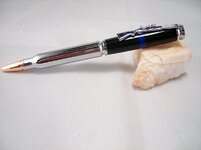Probably incidental reflections or other light sources nearby .... possibly some dust or fingerprint smudging on the pen before photo was taken?
I'm seeing extra light reflected from random spots on the pen too. My first reaction was to think- Oh ... a few scratches ... he should have polished that up a bit better.
My finishing technique is generally to wet-sand with micromesh up to 12,000 grit, like you do ... and then apply PlastX for a final polish, and then top it off with Turtle Wax Hard Surface wax. I hear that a wax on top helps with keeping fingerprints off the pen, repels water from the surface, and helps to deepen the shine and gloss of the finish.
If you don't have any of those top-coat compounds, ask some car enthusiasts if they'll let you borrow a little bit to try to see if you like it.
I blew it up for better detail .... and added some arrows to point out what I can see.
The arrows each point to some reflected/refracted light that appear to be scratches. Some are in line with the pen, some are at an angle or are just small points ....
The area that is circled is showing definite signs of radial lines. Polishing with PlastX can reduce marks like this substantially, but sanding laterally in between grits is the best and most effective means of getting rid of them.


